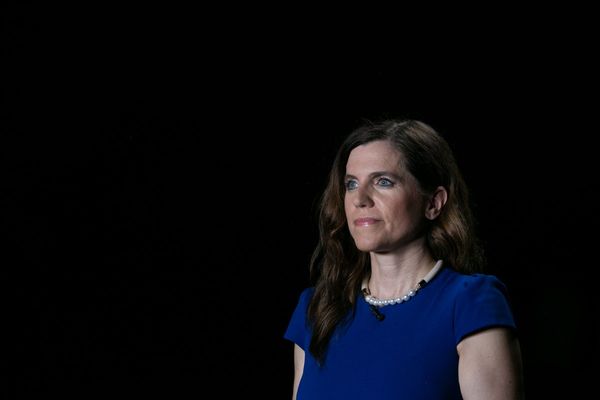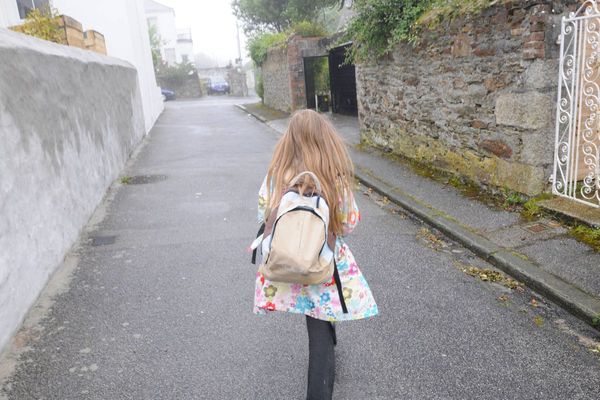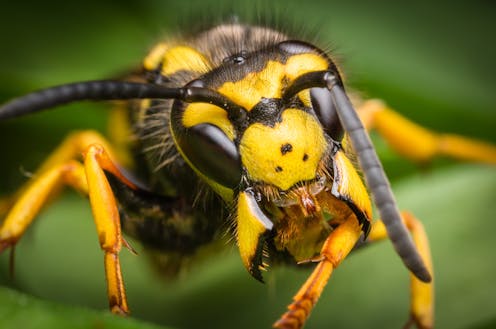
It’s spring in England. The daffodils are in full bloom. A queen yellowjacket (Vespula) wasp emerges from your loft, dopey with hibernation and hungry for nectar. She starts to build a paper nest in which to raise a family. It will be a large family. But for now, she works alone.
Wasps are poorly studied compared with other social insects, like bees and ants. But wasp societies are a fascinating example of a social insect (an insect that lives in a group) because their societies are so varied. Comparing their genetic makeup with other social insects helps bolster our understanding of how animal societies evolved.
My team sequenced the genes involved with social behaviour from nine wasp species to explore what makes a queen (or a worker). What we found challenges a popular scientific view about the molecular machinery that makes insect societies tick.
The shared division of labour, in the form of queen and worker castes, is the secret to success for all social insects. Castes evolved independently at least eight times in Hymenoptera – that’s bees, wasps and ants.
When her first brood hatches, the yellowjacket queen becomes a dedicated egg producer. Her worker offspring will take over extending the nest and foraging for prey to feed to the baby siblings. The workers will never be queens. Like tissues in your body, the queen and her workers divide the chores of the society between them: seamless cooperation between two forms of wasp.
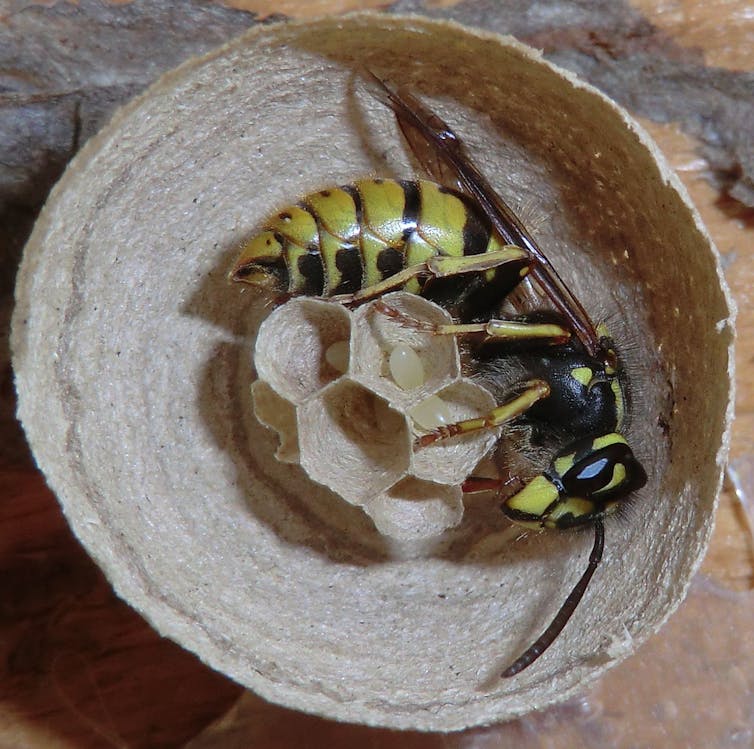
Socialising that comes with a sting
By contrast, in other societies, like Metapolybia wasps in Trinidad, many queens and workers will search together for a new place to nest. The swarm selects a tree trunk and starts to build a papery nest that resembles a cow pat.
For now, there are many queens and many workers, but after a few weeks of growing the nest, a single queen reigns. Scientists don’t know how the queen is chosen but those who don’t make the final cut act as workers. Young Metapolybia workers are “totipotent” which means they can become queen if the resident queen dies. Older workers, however, have been through a form of insect “menopause” and can’t reproduce.
Other wasp societies are simpler. Take the Polistes paper wasps that live along the banks of the Panama Canal, where their nests hang like the soles of old shoes from trees, bridges and houses. Dozens of chestnut bodies sit on a nest: every female is totipotent, but only one wasp is queen at any one time. When the queen dies, the hierarchy breaks down and they fight viciously to replace her.
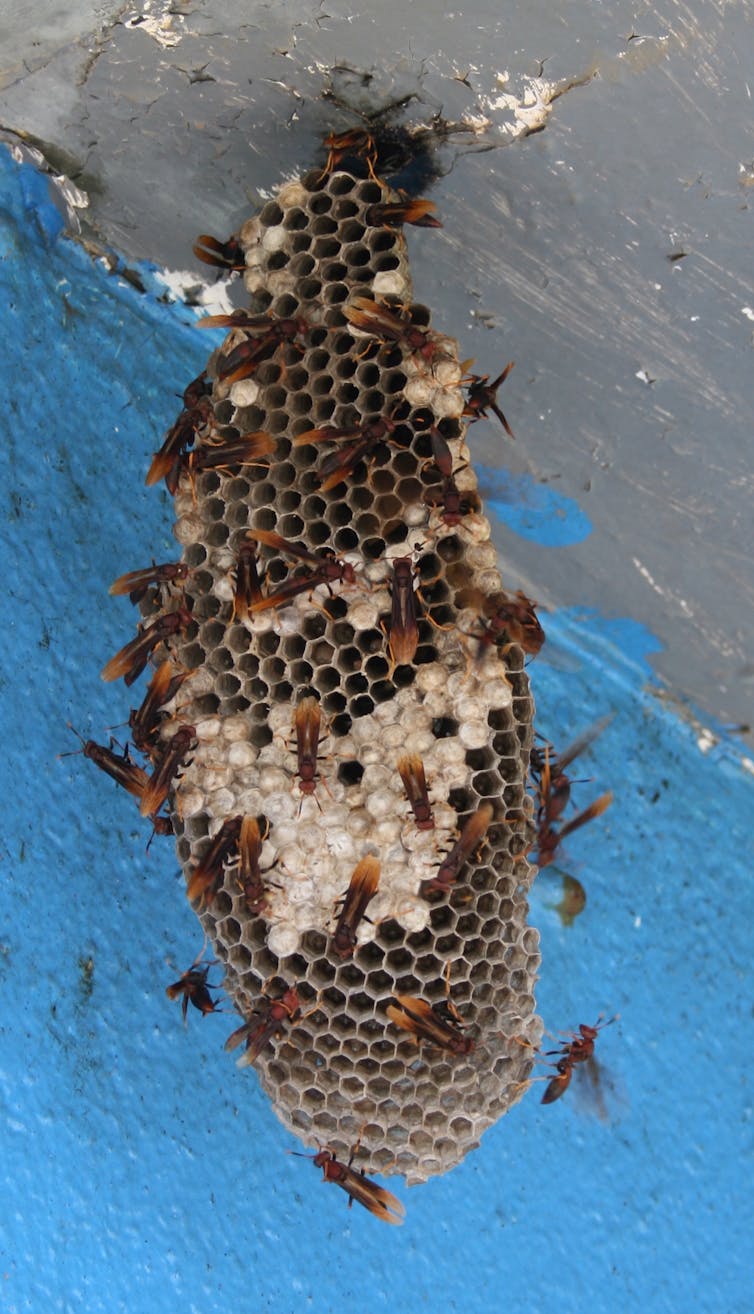
Thanks to advances in molecular biology, we now know queens and workers in insect societies are different expressions of the same genome (the entire set of DNA instructions found within a cell). The physiological and behavioural differences that allow castes to perform their specialist tasks are because the colony’s shared genes are activated differently. Hundreds of genes separate queens from workers in the honeybee. Some of the same genes separate castes in fire ants, bumblebees and paper wasps. There’s a shared social toolkit.
At least scientists thought so.
What we learned
One problem is that comparing data across different species, methods and labs is tricky. You’re not comparing like for like. Researchers tend to focus on a few popular species and different labs may generate results in different ways. It’s difficult to compare data sets because it is easy to fall into the trap of cherrypicking the genes we expect to see in a social toolkit for the “usual suspects”.
My team took a look at the bigger picture. We sequenced the genes activated in the brains from nine genera (biological classes) of social wasps from around the globe, including representatives of some of the simplest and most complex societies known in the animal kingdom. We focused on brains because differences in brain genome activation shape behaviour like foraging, mating and nest building, and physiology, such as egg production. We also used the same sampling and sequencing techniques across all our species.
We used artificial intelligence (AI) because computers are better at spotting patterns than humans as they can process more complex patterns faster. They are also more objective. The computer was trained to identify castes. We then asked it to classify samples as queens or workers, based on the patterns of which genes were activated in a sample.
If the social toolkit hypothesis was correct, we should have seen swathes of shared activation profiles for queens and workers across all species.
The machines found some evidence for this. From over 5,000 orthologous genes (genes shared by all species), the computer correctly identified queens and workers for seven of the nine species. Intriguingly, the results showed queens are characterised by more inactive genes compared with workers, perhaps because workers perform a wider repertoire of tasks, while queens are egg-laying specialists.
But the complexity of a society also matters. Our AI methods showed the shared molecular toolkit provides the basic recipe that is enough for simpler societies. But additional molecular processes are needed for the more complex societies. Especially those that are superorganisms, like the yellowjacket wasps.
The machinery used to create a totipotent paper wasp worker isn’t necessarily the same as that required to make a lifetime committed sterile yellowjacket worker.
Our results showed the molecular toolkit for social life is more complex than previously thought. My team’s study found that the type of colony influences the way evolution tinkers with the building blocks of life to create societies.
Life history complicates this even further. Whether a species builds new nests alone (like the yellowjacket) or with a swarm of other queens and workers (like Metapolybia) can influence the social toolkit too.
Limiting our scientific focus to a few popular species has given us a blinkered view of evolution’s great experiment: societies. The transition from simple groups (like paper wasps) to the highly complex machines of the superorganisms (like the yellowjackets) may require a fundamental shift in molecular machinery. Like all of life’s greatest challenges, innovation is the key to success.
Seirian Sumner receives funding from the Natural Environment Research Council (NERC). She is an employee of University College London. Her book Endless Forms: Why We Should Love Wasps, is published by William Collins in paperback on March 30th 2023. It reveals the full diversity of wasps, solitary and social, and aims to help readers appreciate the many benefits that wasps offer to ourselves and our planet.
This article was originally published on The Conversation. Read the original article.


